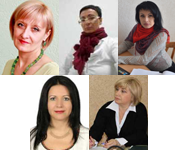Abstract
This article is dedicated to one of the essential problems of improvement of the quality of education in the higher educational institutions in Ukraine nowadays that is the introduction of crossmedia into the educational process. In the article, based on the author's own experience, the essential characteristics of the cross-media, the importance of the formation of cross-media competencies in the Humanities graduates are disclosed and the effectiveness of the introduction of cross-media as an innovative technology in their training is analysed. The peculiarities of transformation and modernization of the modern didactic space are described, Ukrainian and foreign scientific and methodological works on the problem of the introduction of cross-media technologies into the educational process are reviewed, the theoretical aspects of this problem are studied, preferable sources of information and most popular platforms among students based on content analysis of ethnocentric questionnaire (hand delivered questionnaire) are revealed. An emphasis is made on the necessity to conduct media education in formal, informal and accidental ways, which lead to the formation of one’s own media product in the sphere of one’s personal interests. The author also paid special attention to the package of licensed programmes such as AdobeAudition, InDesign, Photoshop, AdobePremiere for the production of the multimedia content of high quality. On the basis of the new technological equipment the students who obtain higher education have an opportunity to realise their students’ media projects and create the journalist content in such forms as: printed production with the on-line version, video- and audio-podcasts, infographics, videoconnection, webinars etc. The effectiveness of the student-centered attitude in the educational process that motivates the future specialists to self-knowledge, self-development and self-education is substantiated. It is proved that the introduction of such technologies affects the modernization of the educational process in the higher education institution, provides the maximum approximation of education to the conditions of the future career.References
J.- N. Kretsu, M. Guzun, and L. Vasylyk, Cross-Media Handbook, Sibiu: Schiller Publishing House, p. 21, 2015 (in Ukrainian).
N. Poplavska, and N. Dashchenko, "Formation of cross-media competence of student-journalists. State and regions". Series: Social Communications, № 3-4, p. 113-117, 2013 (in Ukrainian).
M. O. Synytsa, "Use of multimedia technologies in the educational process of higher educational institutions as a means of formation of pedagogical knowledge", in Professional pedagogical education: formation an development of pedagogical knowledge: monography, ed. prof. O. A. Dubaseniuk, Zhytomyr: Publishing house of ZHSU named of I. Franko, 2014, p. 418-438 (in Ukrainian).
H. Synorub, "Cross-media as a "higher league" in journalism" [online]. Available: https://academia.in.ua. Accessed on: February 07, 2014 (in Ukrainian).
R. Holfeld, F. Muller, А. Richter, and F. Zaher, "Crossmedia-train is gaining ground. Who will fall as a victim?", in Material on the seminar "Cross-media and Qualitative Journalism", Passau-Sibiu, March, 20-24, 2013 (in Ukrainian).
J. Bednarek, and E. Lubina, Kształcenie na odległość, podstawy dydaktyki. Warszawa, Poland: Wydawnictwo Naukowe PWN, 2008 (in Polish).
D. Nojszewski, "Platformy e-learningowe w polskich instytucjach edukacyjnych" [online]. Available: http://www.e-mentor.edu.pl/artykul/index/numer/2/id/20. Accessed on: E-mentor nr 2, 2003 (in Polish).
H. Pitler, E.-R. Hubbell and M. Kuhn, "Using Technology with Classroom Instruction" [online]. Available: http://www.ascd.org/Publications/Books/Overview/Using-Technology-with-Classroom-Instruction-That-Works-2nd-Edition.aspx. Accessed on: August, 2012 (in English).
Typy inteligencji. 8 inteligencji według prof. Gardnera [online]. Available: http://dziecisawazne.pl/8-inteligencji-wedlug-prof-h-gardnera. Accessed on: 2018 (in Polish).
K.Witek, "Wartość m-learningu dla kształcenia ustawicznego w kontekście przykładowych projektów europejskich" [online]. Available: http://www.e-mentor.edu.pl/artykul/index/numer/28/id/619. Accessed on: E-mentor nr 1 (28), 2009 (in Polish).
K. Wereszczynski, Wykorzystanie technologii informacyjnych w procesie kształcenia na przykładzie seminarium dyplomowego, in Koncepcje i praktyka e-edukacji, red. M. Dąbrowski, M. Zając, Warszawa, Poland: Wydawnictwo Fundacja Promocji i Akredytacji Kierunków Ekonomicznych, 2011 (in Polish).
K. Pająk "Technologia Ksztalcenia w Wyzszej Uczelni" [online]. Available: technologia_ksztalcenia_w_wyzszej_uczelni_k_pajak. Accessed on: 2017 (in Polish).
Authors who publish in this journal agree to the following terms:
- Authors hold copyright immediately after publication of their works and retain publishing rights without any restrictions.
- The copyright commencement date complies the publication date of the issue, where the article is included in.
Content Licensing
- Authors grant the journal a right of the first publication of the work under a Creative Commons Attribution-NonCommercial-ShareAlike 4.0 International License (CC BY-NC-SA 4.0) that allows others freely to read, download, copy and print submissions, search content and link to published articles, disseminate their full text and use them for any legitimate non-commercial purposes (i.e. educational or scientific) with the mandatory reference to the article’s authors and initial publication in this journal.
- Original published articles cannot be used by users (exept authors) for commercial purposes or distributed by third-party intermediary organizations for a fee.
Deposit Policy
- Authors are permitted and encouraged to post their work online (e.g., in institutional repositories or on their website) during the editorial process, as it can lead to productive exchanges, as well as earlier and greater citation of published work (see this journal’s registered deposit policy at Sherpa/Romeo directory).
- Authors are able to enter into separate, additional contractual arrangements for the non-exclusive distribution of the journal's published version of the work (e.g., post it to an institutional repository or publish it in a book), with an acknowledgement of its initial publication in this journal.
- Post-print (post-refereeing manuscript version) and publisher's PDF-version self-archiving is allowed.
- Archiving the pre-print (pre-refereeing manuscript version) not allowed.


